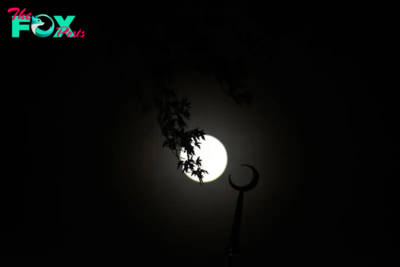Science
How to watch the 'Harvest Supermoon' get eclipsed by Earth next week
On Tuesday, Sept. 17, the full Harvest Moon will rise and be partially eclipsed by Earth. Observers in North America, South America, Europe and Africa will get the best views of the lunar eclipse, with Saturn shining brightly close to the moon throughout the event.
The final full moon of the summer this year, September's full moon is called the Harvest Moon in the Northern Hemisphere because it rises close to sunset for a few evenings in a row, historically giving farmers extra moonlight to help them bring in the harvest, according to Almanac.com.
It's also a supermoon, meaning our natural satellite will appear slightly bigger and brighter than usual. That's because the moon's monthly orbit around Earth is slightly elliptical. When the moon reaches its closest point to Earth each month, known as perigee, during a full moon, it looks larger in Earth's sky. September's supermoon will be the second of four successive supermoons in 2024, following last month's blue supermoon.
Related: Supermoon Blue Moon 2024: Top photos from around the world
Although the full moon will be a spectacular sight at moonrise where you are, the lunar eclipse doesn't begin until later. The moon will be officially full at 10:34 p.m. EDT, shortly before the partial eclipse peaks.
During the eclipse, first the moon will drift into Earth's penumbra — its fuzzy outer shadow in space — losing its brightness over about 90 minutes. This penumbral eclipse phase will happen between 8:41 p.m. and 10:13 p.m. EDT.
—The best meteor showers of 2024 are yet to come. Here are the key nights to watch for.
—See the moment the blue supermoon 'gobbled up' Saturn in epic astrophotography image
—Why is a 'once-in-a-decade' Supermoon Blue Moon happening twice in 2 years?
The moon will then graze Earth's darker inner shadow, the umbra. Although only 8.4% of the lunar surface will recede into the umbra, according to NASA, this is the dramatic partial eclipse phase. You can watch it between 10:13 p.m. and 11:15 p.m. EDT, with the peak eclipse moment being 10:44 p.m. EDT. At that point, the eclipse phases will go into reverse as the moon begins to leave Earth's shadow, with the final penumbral phase taking place between 11:15 p.m. and 12:47 a.m. EDT. You can see a full schedule for your location via timeanddate.com.
-

 Science5h ago
Science5h agoHow to See the ‘Beaver’ Supermoon—the last of 2024
-

 Science5d ago
Science5d agoInside Capitol Hill’s Latest UFO Hearings
-

 Science5d ago
Science5d agoYou Won’t Want to Miss the Leonid Meteor Shower. Here’s How and When You Can See It
-

 Science6d ago
Science6d agoHere’s What Trump’s Win Means for NASA
-

 Science1w ago
Science1w agoWhy Risky Wildfire Zones Have Been Increasing Around the World
-

 Science1w ago
Science1w agoIt’s Time to Redefine What a Megafire Is in the Climate Change Era
-

 Science1w ago
Science1w ago4 Astronauts Return to Earth After Being Delayed by Boeing’s Capsule Trouble and Hurricane Milton
-

 Science1w ago
Science1w agoThe Elegance and Awkwardness of NASA’s New Moon Suit, Designed by Axiom and Prada



























